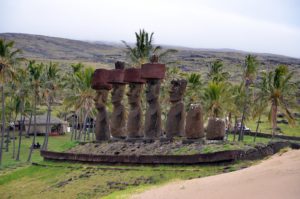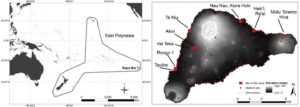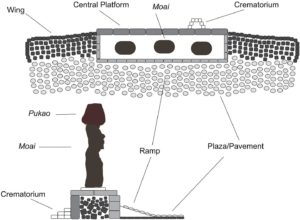
University of Oregon and Binghamton University—The timing of the collapse of Easter Island’s monument-building society did not occur as long thought, according to a fresh look at evidence by researchers at four institutions.
The island of Rapa Nui, otherwise known as Easter Island, is well-known for its elaborate ritual architecture, particularly its numerous statues (moai) and the monumental platforms that supported them (ahu). A widely-held narrative posits that construction of these monuments ceased sometime around 1600, following a major societal collapse. Located about 3,000 kilometers (1,864 miles) from South America and 2,000 kilometers (1,242 miles) from any other inhabited island, it is believed to have been settled in the 13th century by Polynesian seafarers. They soon began building massive stone platforms stacked with megalithic statues and large, cylindrical stone hats that were used for cultural and religious rituals, including burial and cremation. A widely-held narrative is that monument construction stopped around 1600 after a major societal collapse.
Researchers, led by the University of Oregon’s Robert J. DiNapoli, examined radiocarbon dates, relative architectural stratigraphy and ethnohistoric accounts to quantify the onset, rate and end of monument construction as a means of testing the collapse hypothesis.
“Archaeologists assign ages to the archaeological record by getting what are known as radiocarbon dates,” said Carl Lipo, an anthropologist at Binghamton University. “These dates represent the amount of time since some organisms (a bush, tree, etc.) died. Assembling groups of these dates together to look at patterns requires some sophisticated statistical analyses that have only recently been available to archaeologists. In this paper, we use these tools to provide the first-ever look at the history of platform construction on Easter Island.”
The project began as part of DiNapoli’s dissertation, which is focused on the process of building the monuments’ architecture. Looking at 11 sites, the researchers examined the necessary sequence of construction, beginning with building a central platform and then adding different structures and statues.
That helped make sense of differing radiocarbon dates found at various excavation sites. Monument construction, according to the team, began soon after initial Polynesian settlement and increased rapidly, sometime between the early 14th and mid-15th centuries, with a steady rate of construction events that continued well beyond the hypothesized collapse and the European arrival.
When the Dutch arrived in 1722, their written observations reported that the monuments were in use for rituals and showed no evidence for societal decay. The same was reported in 1770, when Spanish seafarers landed on the island.
“Their stays were short and their descriptions brief and limited,” DiNapoli said. “But they provide useful information to help us think about the timing of building and using these structures as part of their cultural and religious lives.”
However, when British explorer James Cook arrived four years later, in 1774, he and his crew described an island in crisis, with overturned monuments.
“The way we interpret our results and this sequence of historical accounts is that the notion of a pre-European collapse of monument construction is no longer supported,” DiNapoli said.
“Once Europeans arrive on the island, there are many documented tragic events due to disease, murder, slave raiding and other conflicts,” said co-author Carl Lipo, an anthropologist at Binghamton University in New York.
“These events are entirely extrinsic to the islanders and have, undoubtedly, devastating effects. Yet, the Rapa Nui people – following practices that provided them great stability and success over hundreds of years – continue their traditions in the face of tremendous odds,” he said. “The degree to which their cultural heritage was passed on – and is still present today through language, arts and cultural practices – is quite notable and impressive. I think this degree of resilience has been overlooked due to the collapse narrative and deserves recognition.”
“What we found is that once people started to build monuments shortly after arrival to the island, they continued this construction well into the period after Europeans arrived,” said Lipo. “This would not have been the case had there been some pre-contact “collapse”—indeed, we should have seen all construction stop well before 1722. The lack of such a pattern supports our claims and directly falsifies those who continue to support the ‘collapse’ account.
The researchers believe that their model-based approach to test hypotheses regarding the chronology of collapse can be extended to other case studies around the world where similar debates remain difficult to resolve.
___________________________

Ahu Nau Nau, a cultural and religious site built by Rapa Nui society on Easter Island’s Anakena beach, was among 11 sites where previously gathered data were examined as part of the new study led by University of Oregon doctoral candidate Robert DiNapoli. The site is located on the north shore of the Easter Island. Robert DiNapoli
___________________________

East Polynesia (left), and Rapa Nui showing the locations of all documented platform ahu as well as those analyzed in this study (right). Journal of Archaeological Science
___________________________

Schematic of a typical platform ahu showing a plan view (top) and cross-section (bottom). Figure adapted from Martinsson-Wallin (1994) and Skjølsvold (1994). Journal of Archaeological Science
___________________________
___________________________
Article Source: University of Oregon and Binghamton University news releases
The paper, “A model-based approach to the tempo of collapse: The case of Rapa Nui (Easter Island),” was published in the Journal of Archaeological Science. Also contributing to this research were Timothy M. Rieth (International Archaeological Research Institute) and Terry Hunt (University of Arizona).
The research was funded by the National Science Foundation.
___________________________
Advertisement





